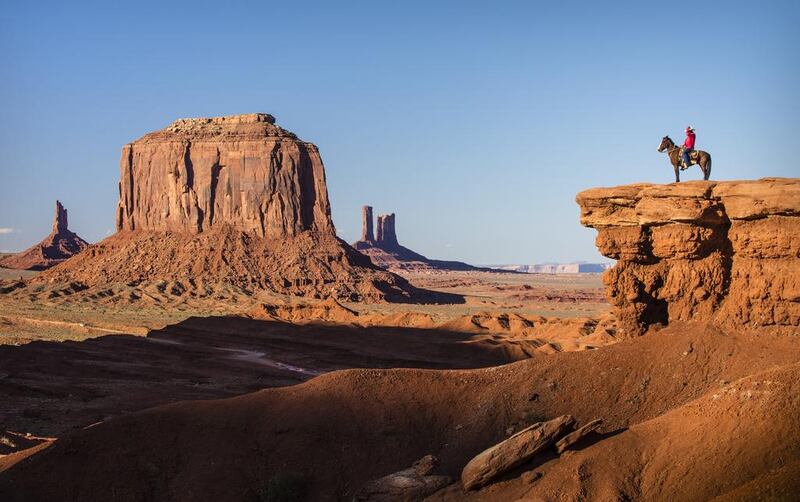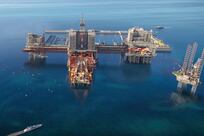The absurd novelty hotels soon give way and the sheer gigantism of the Las Vegas Strip is exposed as a fantasy. Beyond the city is a stark desert, not of rolling sand dunes but of scrubby, rubbly, tree-free hills. There’s a sense of epic unfolding below the clacking rotor blades of the helicopter – of a landscape fit for rattlesnakes and cacti.
But it’s not just Las Vegas that has conquered the setting. Charging through the middle of this cowboy landscape is the galloping Colorado River, relentless on its way from the Rocky Mountains to the Gulf of California.
Yet as the Colorado forms the border between Nevada and Arizona, man has got in the way. The Hoover Dam – a towering barrier of concrete jammed into a canyon – tames the river and creates a spindly, floodplain-covering lake. The people of the desert have a water supply and somewhere to go boating.
The flight continues and the scenery gets more dramatic until the descent to a rocky riverside perch. Around us, walls soar up to join the sky. We’re inside the Grand Canyon – it didn’t get the name by accident.
By the water’s edge, a raft awaits. This land belongs to the Hualapai people, a native American tribe that called the western stretch of the canyon home long before tourists came in their droves. The raft putters downstream as a bald eagle watches from its treetop perch, and an appreciation of the Grand Canyon begins to dawn. It’s not just one tidy slot, but an eye-popping series of ancient splinters, fracturing the landscape in easily perceptible layers. From above, it looks like a cartoonist has drawn an earthquake. From inside, you feel shut off from the rest of the world. It’s a vast, intimidating, alternate universe.
The Hualapai are not the only tribe to have semi-autonomous lands in the United States. Many reservations and “countries” are spread across the largely empty expanses of the south-west. Driving through this desert corner of the North American continent, the signs of the native lands spring up time and time again. Many of them somewhat disheartening. Road quality tends to dip, running casinos is often seen as a primary income source and the disconnect between traditional ways and modern life causes divides.
But the stories can be extraordinary. In north-eastern Arizona, the town of Kayenta in the Navajo Nation acts as a gateway to Monument Valley. But it contains what is perhaps the world’s most fascinating Burger King.
Part of it has been turned into a museum, devoted to one of the most unlikely stories of the Second World War. The US forces had a real problem with the Japanese intercepting messages and using the information to plan attacks. A code was needed, and it turned out the hardest to crack was based on a language that the Japanese simply didn’t know existed. Navajo men were trained up and embedded with units in military theatres across Asia. When messages needed to be sent, the Navajo were given the radios. The enemy didn’t know what was going on.
Down the road, towards the Utah border, is what decades of cowboy films have implanted in the collective consciousness as the American West. Almost everyone who arrives in Monument Valley is hit by the feeling that they’ve been there before. Giant sandstone buttes shoot out of the red dirt floor, set against a crisp blue sky, mysteriously isolated with nothing else around to explain their presence.
For clues, it pays to get out of the car along the juddery dirt track that makes a rough-and-ready circuit around the valley. The stratification lines on one butte match up to those on another. Time – thousands of years of it – has slowly eaten away at what used to lie in between. These aren’t new growths; they’re remnants of something much bigger and long-since forgotten.
Driving east into New Mexico soon becomes a climb. Most of the state is at high altitude, as the tail end of the Rockies passes through. For the driver, the benefits of this soon become immediately obvious. Trying to find a dull road in New Mexico is quite the task.
Dull is a word that really can’t be applied to this most complex and distinctive of states. There’s a pronounced mix of Hispanic, Native American and Anglo-American cultures. Adobe-built Pueblo Indian villages still stand, Taos plays home to an odd mix of hippies and skiers, while Santa Fe is overrun with artists and authors.
But New Mexico also has an air of mystery about it. Roswell is home to the most famous UFO sighting in history, black stealth fighters can often be spotted near – silently shooting across the skies – and sections of the desert are roped off for military testing.
The most infamous of these tests – that of the first atom bomb – was plotted high on a mountain plateau to the north-west of Santa Fe. The story of Los Alamos, as told inside the Bradbury Science Museum there, is incredible. In total secrecy, some of the world’s finest minds were gathered inside an old ranch school. The site didn’t officially exist – everyone just gave their address as a Santa Fe postcode – and the vast majority of the people working at what became a ballooning temporary town didn’t know what they were working on.
Inside is a letter from a technician who worked on the detonators. He didn’t know the grander scheme of things until he read about the Hiroshima bombing in the newspapers. Even President Truman didn’t know of the place’s existence until the second week of his presidency.
The reactions of those who did know what was going on are even more chilling. After the initial successful test, many of the scientists wrote to the President begging him not to use their terrible creation. The project leader Robert Oppenheimer reacted by quoting an ancient Hindu text: “Now I am become death, the destroyer of worlds.”
Human achievements of a less grimly destructive nature are celebrated in Albuquerque, New Mexico’s largest city. The Anderson-Abruzzo International Balloon Museum has the somewhat high-tech basket of the Breitling Orbiter 3, the first balloon to manage a non-stop circumnavigation of the globe. Other ballooning record breakers – the highest altitude, the first across the Pacific – are represented, but they’re not here by accident.
Albuquerque’s annual ballooning festival, held every October, is the largest in the world, with hundreds of balloons taking to the skies at once. The rest of the year, though, high altitude and stable, dry weather conditions make it a perfect place for joy flights. Early starts make for bleary eyes, but the roar of the burners and gulp-provoking heights above the ground soon shake off any feelings of sleepiness. From up high, the combination of mountains, desert and urban sprawl makes for a magical spectacle. Everything seems bigger here.
If you’re wanting to get truly far off the ground, however, the gateway into space is to the south, near the scruffy (and very oddly named) spa town of Truth or Consequences. Spaceport America is where the first commercial space flights will depart from. Virgin Galactic, which is co-owned by Abu Dhabi’s Aabar Investments, says that it still expects that to be later this year, though no date has been specified.
The Spaceport is found in the middle of fairly sparse ranching land, where cows mooch up to the boundary fences. It’s quiet and dry out here, and that’s partly why the site was chosen. “It was easier to get a Federal Aviation administration licence in a sparsely populated area,” explains my tour guide Tyson Rush. “And the weather means we get an average of 340 days a year where a launch is possible.” Having the White Sands Missile Range as a neighbour is also helpful – the no-fly zone there keeps the skies free of scheduled flights that would otherwise need planning around and military jets are quickly scrambled if needed for security reasons.
“Elevation is important,” says Tyson. “The higher you are at launch, the cheaper it is to get into space. And latitude counts too – we’re about as close as we can get to the equator while still being somewhere with reliable weather patterns.”
At the moment, Follow The Sun’s tours are the only way into the Spaceport, and the real surprise is in how minimalist it is. The buildings on site are deliberately built to blend in with the surroundings. The main terminal building looks rather like architect Norman Foster has been let loose to design an alien spaceship, but it’s covered in earth. Native vegetation will eventually be planted on top and the air-traffic-control tower is on the second floor, dwarfed by the mountains in the background.
At the moment, the main terminal building is still largely a shell being kitted out – the tours are not allowed inside. But everything is being built to the specifications of the tenants. “That’s one of the key things,” says Rush. “It isn’t an old military base that has been repurposed.”
Virgin Galactic is the main tenant, but various other companies will use the facilities for the likes of space research and launching satellites. It is, however, possible to go inside the fire and security building. And, again, the surprise comes in how functional and unshowy it is – owing more to the adobe huts of New Mexico’s Pueblo villages than a space age Jetsons fantasy. The whole place reeks of the fundamental disconnect between the glamorous public perception of an astronaut’s life and the mundane, ultra-practical realities.
The runway, however, is hardly unobtrusive. It’s more than three kilometres long. “Any vessel known to man could land here,” says Tyson. Anyone walking along it is a mere speck. Yet again, it’s easy to feel very small in the American South-West.





